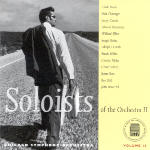Every year for the past quarter-century, the Chicago Symphony Orchestra’s archives are mined for a CD release to tie in with its annual fund-raising radiothon. 2001’s offering proves to be one of this series’ most appealing volumes yet, the second one to focus on soloists within the orchestra’s distinguished ranks. While certain selections (such as Sibelius’ The Swan of Tuonela and the Nielsen Clarinet Concerto) may be more familiar to some listeners than others (Milhaud’s Percussion Concerto and Atterberg’s Suite No. 3, for instance), the repertoire is richly varied, fresh, and unhackneyed. So are the performances.
Debussy’s First Rhapsody leads off Disc 1, with clarinetist Larry Combs weaving his broad, beautiful tone in and out of Pierre Boulez’s finely calibrated orchestral framework. A warm, exquisitely detailed Mozart Sinfonia Concertante follows, featuring a stellar solo quartet with clarinetist Clark Brody, oboist Ray Still, hornist Dale Clevenger, and bassoonist Willard Elliot. What witty elegance and sparkling articulation the foursome brings to the variation movement! The attractive Atterberg Suite’s third movement might strike a first-time listener as a cross between Tchaikovsky and Granados. Violinist Joseph Golan and violist Charles Pikler match each other’s timbres to the point where it becomes hard to tell who’s who without a score in hand. Willard Elliot comes back to team up with Morton Gould on the podium in a sinewy, forward-moving rendition of Villa-Lobos’ breezy Serenade on Seven Notes for Bassoon and Strings. Disc 1 closes with a Swan of Tuonela that’s as poignant, expressive, and controlled as you’ll ever hear, with no small help from conductor Herbert Blomstedt and Grover Schlitz’s magical English horn.
You wonder if the cellist-turned-conductor Antonio Janigro listened with envy as Frank Miller played the Vivaldi E minor Sonata arranged by Vincent D’Indy. Who cares if the string section vibrato is better suited to D’Indy than Vivaldi when you can get Miller’s aristocratic musicality and unmistakable tone? Hummel’s flashy trumpet concerto displays Adolph Herseth’s mega-secure virtuosity at its apex. His high notes and trills alone are enough to keep young, aspiring trumpet players honest. Too bad that Georg Solti’s accompaniment doesn’t match the soloist’s relaxed, playful demeanor. James Ross struts out his percussion artillery in Milhaud’s short and sweet concerto, a raucous tour-de-force whose musical language suggests a steroid-induced Stravinsky L’Histoire du Soldat. I’m even more impressed with Ross’ deft handling of the prominent snare drum counterpoints throughout the Nielsen Clarinet Concerto, but this is really John Bruce Yeh’s show. His masterful handling of the solo part is seconded by Neeme Järvi’s superb conducting.
I save my favorite item for last: the rarely-encountered Introduction, Chanson, and Rondo for Harp and Orchestra by Maurice Thiriet, a French composer best known for his film and ballet scores. This 1936 work is packed to the rafters with ear-grabbing harp effects, felicitous tunes, and ravishing instrumentation. Harpist Edward Druzinsky takes this music and runs away with it, egged on by Jean Martinon’s dazzling, over-the-top conducting. Although this 1966 performance is the earliest recording here, it’s actually the best-engineered item in the set. I hasten to add that none of the selections needs any sonic apology, for the sound is consistently fine and often outstanding as far as broadcast source material goes. What’s more, all proceeds from this set help support the Chicago Symphony, a worthy cause if there ever was one. Now that you’ve read my heartfelt recommendation, you know what to do. Buy it! [7/31/2001]
































